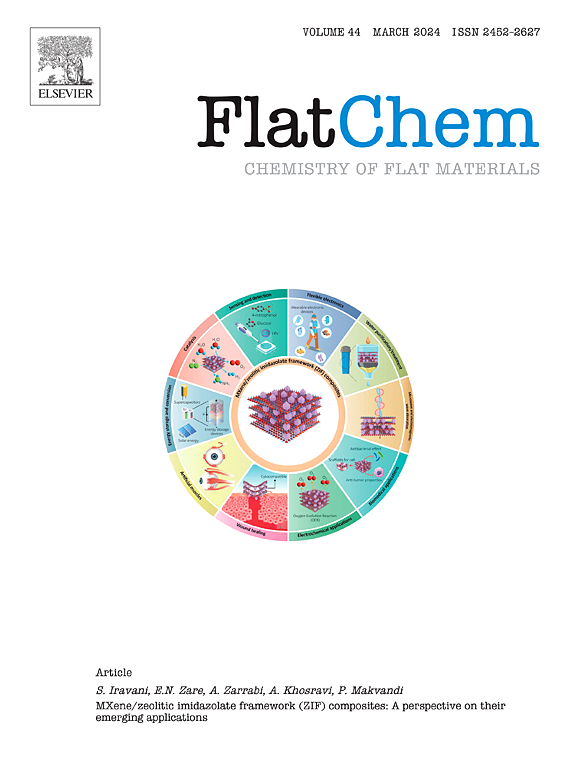Efficient, high-yield, ionized biopolymer-mediated fabrication of exfoliated MoSe2 nanosheets with reversible dispersion properties in water
IF 6.2
3区 材料科学
Q2 CHEMISTRY, PHYSICAL
引用次数: 0
Abstract
Using the environmentally friendly, water-soluble, biopolymer sodium-ion-grafted chitosan (Na-CMC), we achieved efficient exfoliation of bulk molybdenum diselenide (MoSe2) into water-dispersible two-dimensional (2D) exfoliated nanosheets with tunable physical properties and multifunctional characteristics. We successfully developed Na-CMC through a simple, one-step synthetic process. Na-CMC exhibits high solubility and self-assembly properties in water, has strong affinity for the surface of MoSe2, and assists exfoliation of MoSe2 crystals in water on ultrasonic treatment. As the self-assembled Na-CMC structures tightly adhere to the surface of the nanosheets and confer excellent long-term dispersion stability in water, the exfoliated nanosheets possess several unique physical properties, including control over the content of the exfoliated nanosheets, the highest yield of up to 2.05 mg/mL, uniform few-layered sheet structures, and distinctive surface microstructural morphology. Importantly, Na-CMC/MoSe2 solution can be converted into a stably preserved solid sample by freeze-drying, and easily redispersed in water through simple stirring. The redispersed solution maintains the same structure and physical properties as the original Na-CMC/MoSe2 solution, even after multiple freeze-drying/redispersion cycles. The development of this efficient exfoliation technique for 2D nanomaterials based on a bio-based functional polymer offers significant potential to advance the processing and application of 2D nanomaterials.

高效、高产、电离生物聚合物介导的具有水中可逆分散特性的剥离MoSe2纳米片的制备
利用环境友好、水溶性、生物聚合物钠离子接枝壳聚糖(Na-CMC),我们实现了大块二硒化钼(MoSe2)的高效剥离成具有可调物理性质和多功能特性的水分散二维(2D)剥离纳米片。我们通过一个简单的一步合成过程成功地开发了Na-CMC。Na-CMC在水中具有较高的溶解度和自组装性能,对MoSe2表面具有较强的亲和力,在超声处理下有助于水中MoSe2晶体的剥离。由于自组装的Na-CMC结构紧密粘附在纳米片表面,并赋予其在水中良好的长期分散稳定性,脱落纳米片具有几种独特的物理性质,包括控制脱落纳米片的含量,最高产率高达2.05 mg/mL,均匀的少层片状结构和独特的表面微观结构形态。重要的是,Na-CMC/MoSe2溶液可以通过冷冻干燥转化为稳定保存的固体样品,并且通过简单的搅拌很容易在水中重新分散。即使经过多次冷冻干燥/再分散循环,再分散溶液仍保持与原始Na-CMC/MoSe2溶液相同的结构和物理性质。这种基于生物基功能聚合物的二维纳米材料高效剥离技术的发展为推进二维纳米材料的加工和应用提供了巨大的潜力。
本文章由计算机程序翻译,如有差异,请以英文原文为准。
求助全文
约1分钟内获得全文
求助全文
来源期刊

FlatChem
Multiple-
CiteScore
8.40
自引率
6.50%
发文量
104
审稿时长
26 days
期刊介绍:
FlatChem - Chemistry of Flat Materials, a new voice in the community, publishes original and significant, cutting-edge research related to the chemistry of graphene and related 2D & layered materials. The overall aim of the journal is to combine the chemistry and applications of these materials, where the submission of communications, full papers, and concepts should contain chemistry in a materials context, which can be both experimental and/or theoretical. In addition to original research articles, FlatChem also offers reviews, minireviews, highlights and perspectives on the future of this research area with the scientific leaders in fields related to Flat Materials. Topics of interest include, but are not limited to, the following: -Design, synthesis, applications and investigation of graphene, graphene related materials and other 2D & layered materials (for example Silicene, Germanene, Phosphorene, MXenes, Boron nitride, Transition metal dichalcogenides) -Characterization of these materials using all forms of spectroscopy and microscopy techniques -Chemical modification or functionalization and dispersion of these materials, as well as interactions with other materials -Exploring the surface chemistry of these materials for applications in: Sensors or detectors in electrochemical/Lab on a Chip devices, Composite materials, Membranes, Environment technology, Catalysis for energy storage and conversion (for example fuel cells, supercapacitors, batteries, hydrogen storage), Biomedical technology (drug delivery, biosensing, bioimaging)
 求助内容:
求助内容: 应助结果提醒方式:
应助结果提醒方式:


